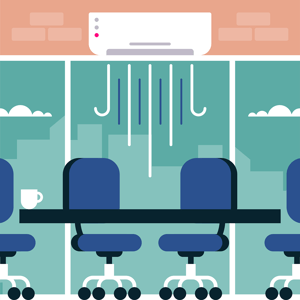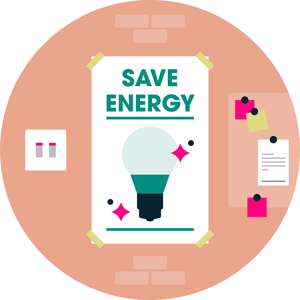Make Your Office Green: Tips to Use Less Energy
Once you’ve taken some steps to cut your energy use at home, you might turn your attention to your workplace. Offices can be particularly wasteful, especially if lights are left blaring overnight and computers are rarely shut down.
So, you can make some easy and effortless energy-saving wins - and win some brownie points from your penny-pinching boss to boot.
Here are some simple starting steps you can take to encourage your workplace to consume less energy.
First, Speak to Your Boss
Almost a third of small firms highlight the cost of energy as a barrier to the growth and success of their business, according to the Federation of Small Businesses.
Wasted energy makes up 30% of the average energy bill - do something about it! Get more from your smart meter with Loop.
So, if you can save your company some money, then your ideas for energy efficiency will be welcomed. Employee of the month, here you come.
For a start, go armed with this compelling stat, from a government report: for a company with a 5% profit margin over three years, a £500-a-year saving from energy efficiency makes the same profit as £30,000 of extra sales.
Control the Heating
It may sound simple, but is someone really thinking about how effectively the heating is used in your office? Quite possibly not.
Turning down the heating in your office by 2 degrees celsius would save £140 on a £1,000 bill. Aim for 19 degrees celsius in an office, or lower in corridors, storerooms and other places where people tend to move around a bit.
Also, use a timer, to keep the heating off on weekends and public holidays.
Similarly, keep the air conditioning under control. It can be a godsend in the summer, but ensure the AC is turned off in meeting rooms when people leave.

Control Draughts
Up to 30% of heating costs can be saved by preventing cold air from entering a building. Again, this is something most people would consider at home but can get overlooked at work.
So, like you would at home, keep doors closed when possible, or consider fitting spring-loaded door closures. Also, identify all sources of draughts and fit appropriate draught proofing.
Set Rules on Equipment Use
According to Carbon Trust, effective management of equipment can reduce its energy consumption by up to 70%. So, it recommends developing and communicating a set of guidelines to include steps like activating stand-by, or sleep modes on PCs, to save power; or setting up printers to print both sides of the paper. Printers and photocopiers that aren’t used that often, should only be turned on when required.
A large part of the problem is equipment being left on overnight, often unnecessarily: 46% of electricity in businesses is used outside of standard operating hours. So, ensure both PCs and monitors are turned off at the plug at the end of the day. Communal equipment, from printers to coffee machines, should also be shut down at home time.
Also, don’t forget that boilers, air conditioning systems and extraction systems all need maintaining to work at their best.
Control the Lights
Lighting can account for up to 40% of a building’s electricity use, according to government stats.
For starters, as you would at home, open any curtains or blinds to make the most of the sunlight. Ensure that whoever is last to leave the office turns the lights out. Simple things like that can get overlooked at work. Be sure it’s clear which switches control which lights.
Also, don’t leave lights on unnecessarily in places like meeting rooms, storage areas, toilets and corridors. But remember in your zeal for energy-saving you’ll need to bear in mind health and safety guidance.
Motion sensors can make this much easier to achieve: in one example, an electronic components manufacturer spent £225 on occupancy sensors for its store area and toilets, and as a result saving £813 and 5 tonnes of CO2e a year. So that initial cost took just three months to be paid off.

Get Others on Board
If you don’t fancy taking a stand at the next team meeting and banging the drum for energy efficiency - and its benefits for the environment - then there’s an easier way. Consider printing out posters to encourage your colleagues to save energy. A simple reminder to 'turn the lights off' can have a big impact over time.
You could also consider a reward scheme to encourage people to help you with your energy efficiency mission. You could, for example, leave treats on desks where monitors have been turned off. Or your company could commit to donating a percentage of the money saved through energy efficiency measures to a charity chosen by employees.
Add EV Charging Points
For employees with electric cars, charging at work can be a convenient way for them to recharge their vehicles whilst parked during the day.
So, if there’s no charging point at your office, look into the government’s Workplace Charging Scheme, which offers financial support for businesses and other employers to have charge points installed at their premises.
Use Loop!
If you’re already a Loop user at home, you’ll know that using Loop is a great way to monitor energy use and identify the appliances that are sapping too much power. Just as Loop would help you cut back on energy use at home, you can apply the same energy-saving instinct to an office or other workplace.
• • •
Cut Your Energy Bill With Loop
Loop is a FREE energy-saving app that links to your smart meter, analyses your energy use and shows you easy ways to save. On average, Loop users cut their energy use by 15%! How much could you save?








